Introduction to Accounting and Finance
VerifiedAdded on 2023/01/07
|20
|3983
|67
AI Summary
This document provides an introduction to accounting and finance. It covers topics such as income statements, break-even analysis, and evaluating business strategies. The document also includes calculations for payback, ARR, and NPV. Suitable for students studying accounting and finance courses.
Contribute Materials
Your contribution can guide someone’s learning journey. Share your
documents today.

Introduction to Accounting and
Finance
Finance
Secure Best Marks with AI Grader
Need help grading? Try our AI Grader for instant feedback on your assignments.
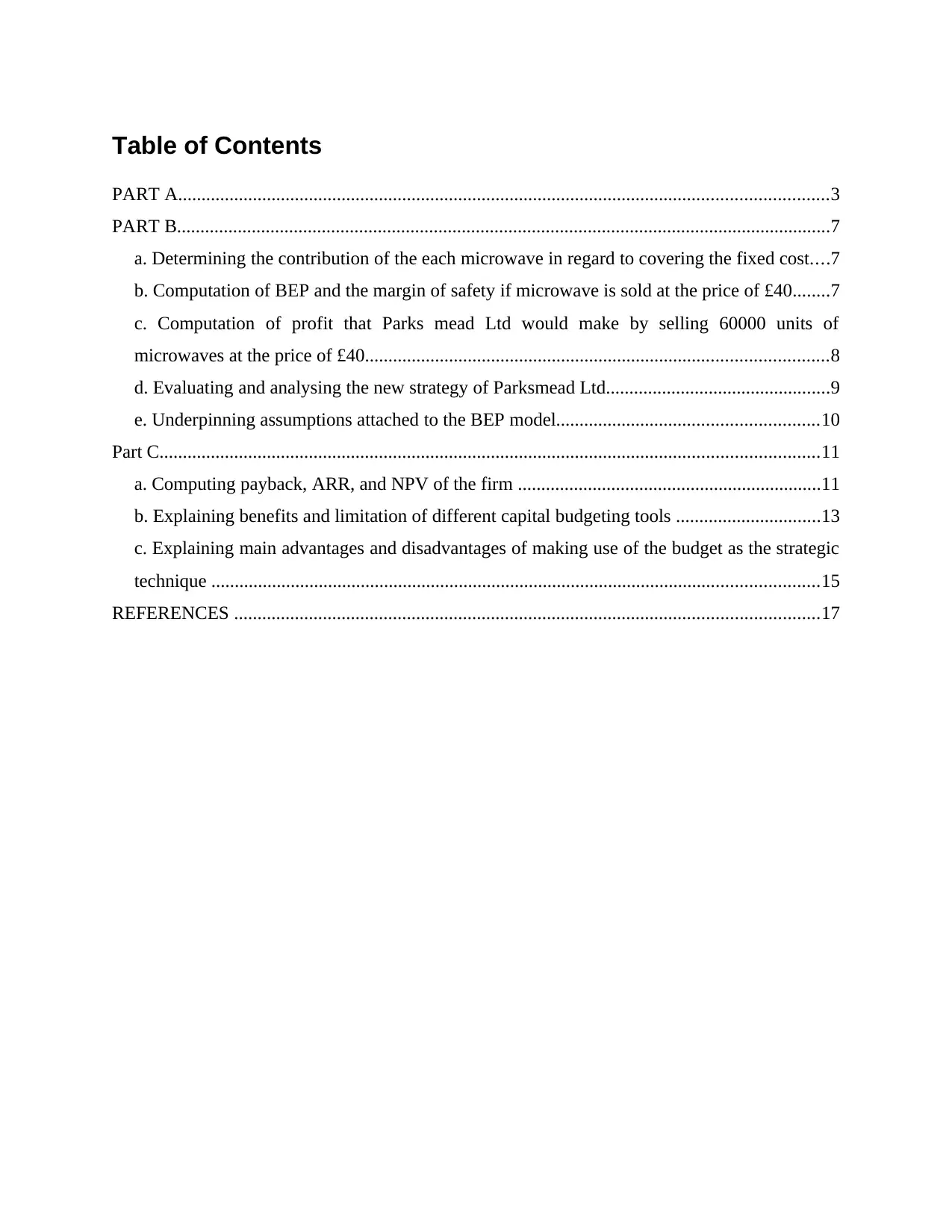
Table of Contents
PART A...........................................................................................................................................3
PART B............................................................................................................................................7
a. Determining the contribution of the each microwave in regard to covering the fixed cost....7
b. Computation of BEP and the margin of safety if microwave is sold at the price of £40........7
c. Computation of profit that Parks mead Ltd would make by selling 60000 units of
microwaves at the price of £40...................................................................................................8
d. Evaluating and analysing the new strategy of Parksmead Ltd................................................9
e. Underpinning assumptions attached to the BEP model........................................................10
Part C.............................................................................................................................................11
a. Computing payback, ARR, and NPV of the firm .................................................................11
b. Explaining benefits and limitation of different capital budgeting tools ...............................13
c. Explaining main advantages and disadvantages of making use of the budget as the strategic
technique ..................................................................................................................................15
REFERENCES .............................................................................................................................17
PART A...........................................................................................................................................3
PART B............................................................................................................................................7
a. Determining the contribution of the each microwave in regard to covering the fixed cost....7
b. Computation of BEP and the margin of safety if microwave is sold at the price of £40........7
c. Computation of profit that Parks mead Ltd would make by selling 60000 units of
microwaves at the price of £40...................................................................................................8
d. Evaluating and analysing the new strategy of Parksmead Ltd................................................9
e. Underpinning assumptions attached to the BEP model........................................................10
Part C.............................................................................................................................................11
a. Computing payback, ARR, and NPV of the firm .................................................................11
b. Explaining benefits and limitation of different capital budgeting tools ...............................13
c. Explaining main advantages and disadvantages of making use of the budget as the strategic
technique ..................................................................................................................................15
REFERENCES .............................................................................................................................17
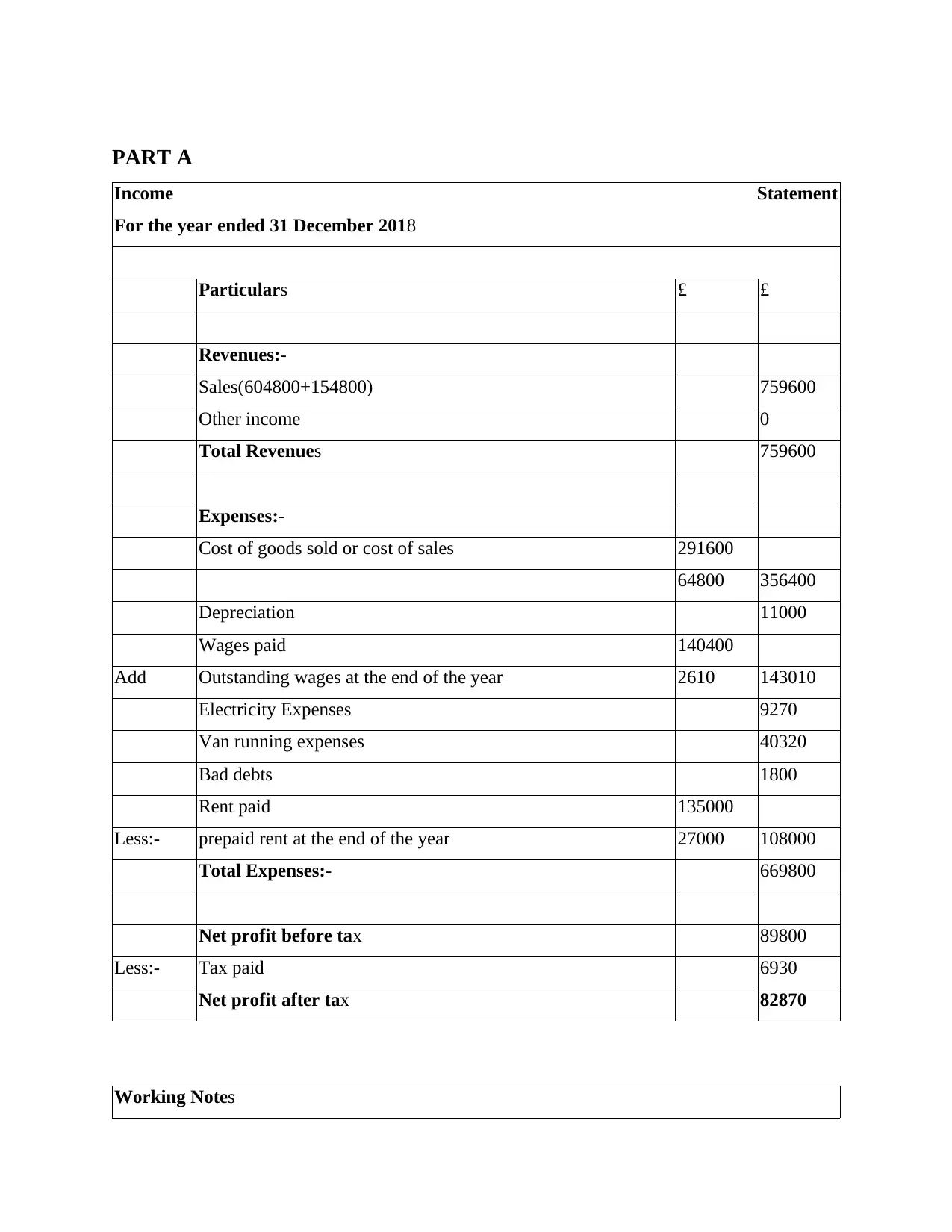
PART A
Income Statement
For the year ended 31 December 2018
Particulars £ £
Revenues:-
Sales(604800+154800) 759600
Other income 0
Total Revenues 759600
Expenses:-
Cost of goods sold or cost of sales 291600
64800 356400
Depreciation 11000
Wages paid 140400
Add Outstanding wages at the end of the year 2610 143010
Electricity Expenses 9270
Van running expenses 40320
Bad debts 1800
Rent paid 135000
Less:- prepaid rent at the end of the year 27000 108000
Total Expenses:- 669800
Net profit before tax 89800
Less:- Tax paid 6930
Net profit after tax 82870
Working Notes
Income Statement
For the year ended 31 December 2018
Particulars £ £
Revenues:-
Sales(604800+154800) 759600
Other income 0
Total Revenues 759600
Expenses:-
Cost of goods sold or cost of sales 291600
64800 356400
Depreciation 11000
Wages paid 140400
Add Outstanding wages at the end of the year 2610 143010
Electricity Expenses 9270
Van running expenses 40320
Bad debts 1800
Rent paid 135000
Less:- prepaid rent at the end of the year 27000 108000
Total Expenses:- 669800
Net profit before tax 89800
Less:- Tax paid 6930
Net profit after tax 82870
Working Notes

1 Total Sales
credit sales 604800
cash sales 154800
759600
2 Depreciation
Purchase Price of Van 72000
scarp value 6000
life in years 6
Depreciation 11000
3 Tax Computation
Tax upto 31 march 2018 2880
Add:- Tax from 1 april 2018 to 31 march 2019 5400
Less:- prepaid tax of 3 months
(from 1january 2019 to 31 march 2019) 1350
6930
4 Electricity Expenses:-
Expenses paid 6840
Add:- Outstanding expenses at the end of the year 2430
9270
Balance Sheet
For the year ended 31 December 2018
credit sales 604800
cash sales 154800
759600
2 Depreciation
Purchase Price of Van 72000
scarp value 6000
life in years 6
Depreciation 11000
3 Tax Computation
Tax upto 31 march 2018 2880
Add:- Tax from 1 april 2018 to 31 march 2019 5400
Less:- prepaid tax of 3 months
(from 1january 2019 to 31 march 2019) 1350
6930
4 Electricity Expenses:-
Expenses paid 6840
Add:- Outstanding expenses at the end of the year 2430
9270
Balance Sheet
For the year ended 31 December 2018
Secure Best Marks with AI Grader
Need help grading? Try our AI Grader for instant feedback on your assignments.
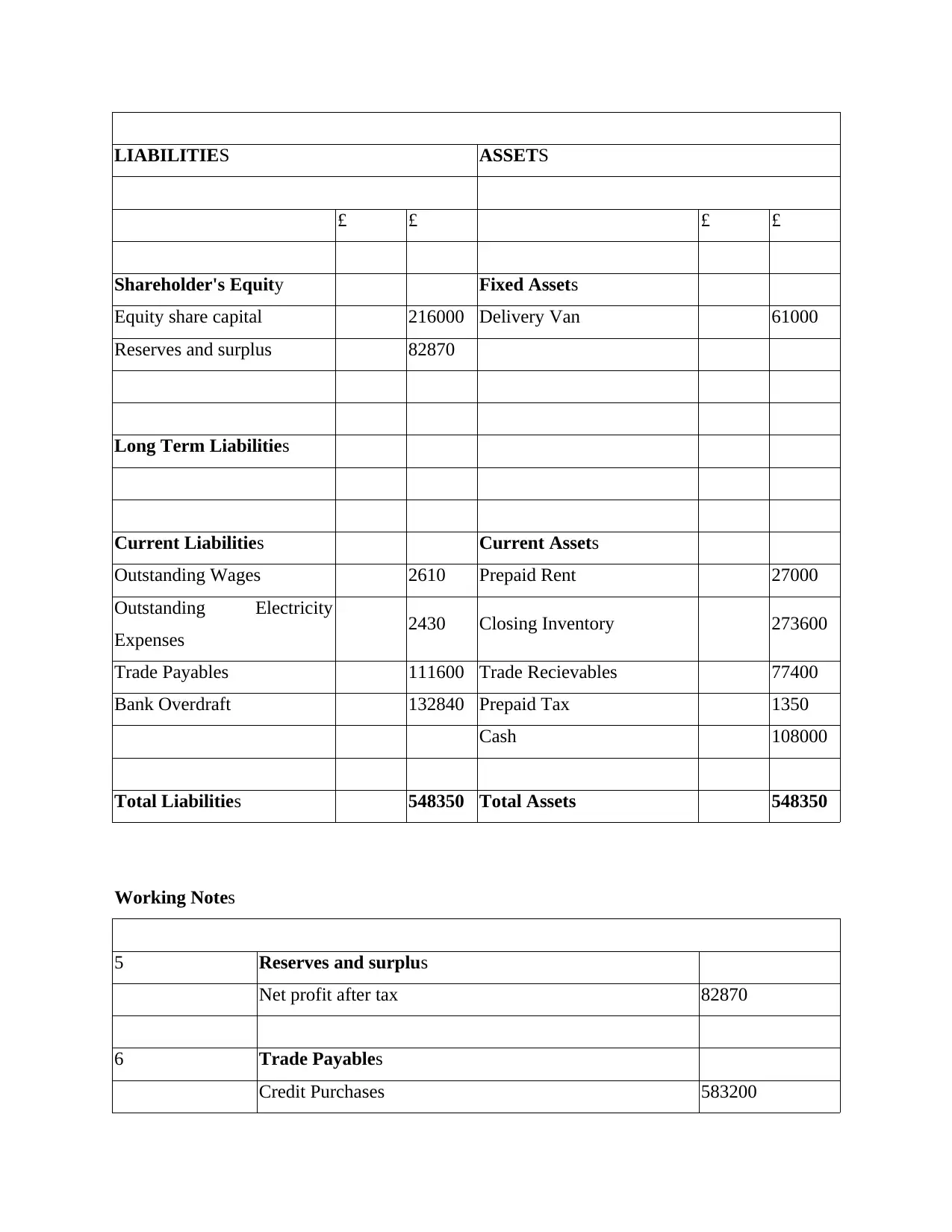
LIABILITIES ASSETS
£ £ £ £
Shareholder's Equity Fixed Assets
Equity share capital 216000 Delivery Van 61000
Reserves and surplus 82870
Long Term Liabilities
Current Liabilities Current Assets
Outstanding Wages 2610 Prepaid Rent 27000
Outstanding Electricity
Expenses 2430 Closing Inventory 273600
Trade Payables 111600 Trade Recievables 77400
Bank Overdraft 132840 Prepaid Tax 1350
Cash 108000
Total Liabilities 548350 Total Assets 548350
Working Notes
5 Reserves and surplus
Net profit after tax 82870
6 Trade Payables
Credit Purchases 583200
£ £ £ £
Shareholder's Equity Fixed Assets
Equity share capital 216000 Delivery Van 61000
Reserves and surplus 82870
Long Term Liabilities
Current Liabilities Current Assets
Outstanding Wages 2610 Prepaid Rent 27000
Outstanding Electricity
Expenses 2430 Closing Inventory 273600
Trade Payables 111600 Trade Recievables 77400
Bank Overdraft 132840 Prepaid Tax 1350
Cash 108000
Total Liabilities 548350 Total Assets 548350
Working Notes
5 Reserves and surplus
Net profit after tax 82870
6 Trade Payables
Credit Purchases 583200
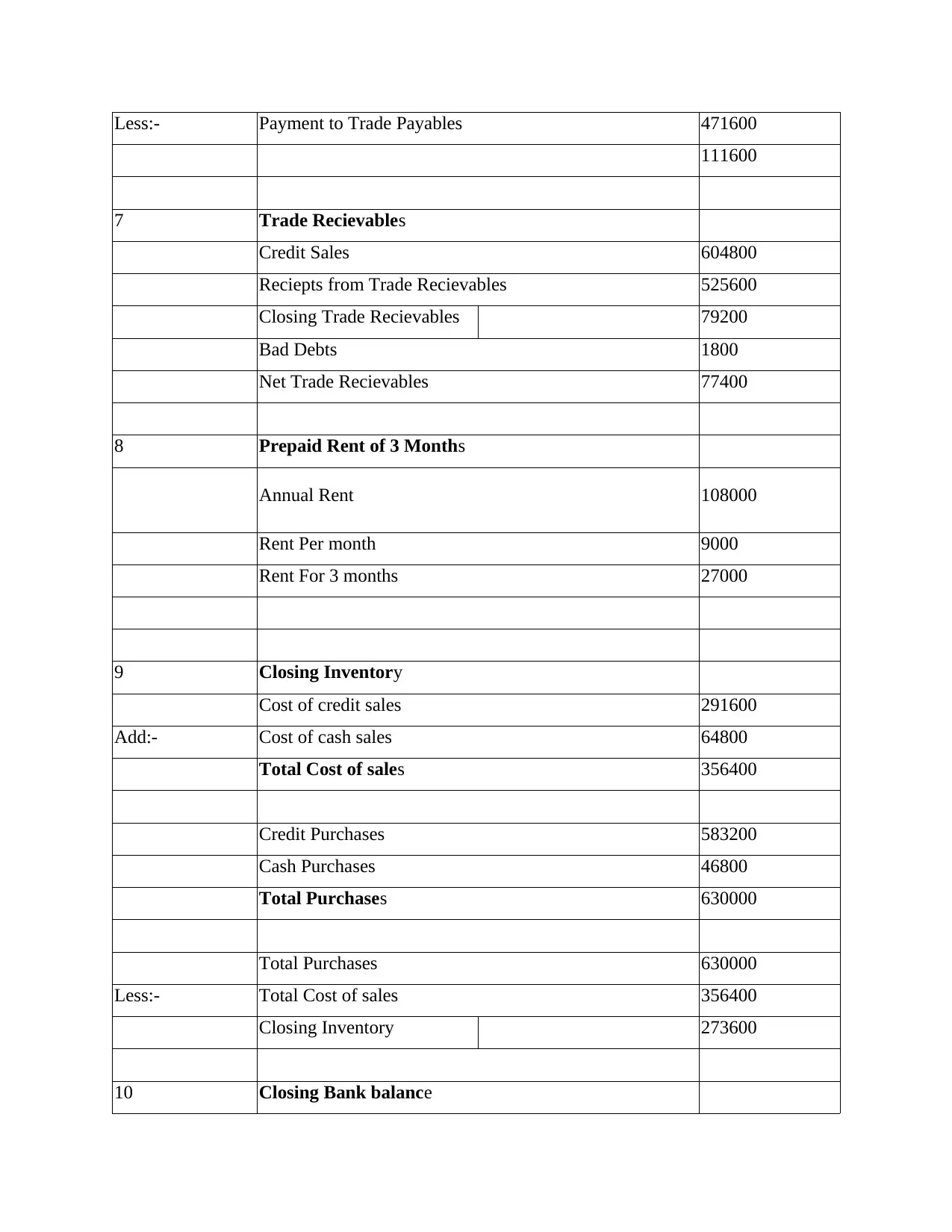
Less:- Payment to Trade Payables 471600
111600
7 Trade Recievables
Credit Sales 604800
Reciepts from Trade Recievables 525600
Closing Trade Recievables 79200
Bad Debts 1800
Net Trade Recievables 77400
8 Prepaid Rent of 3 Months
Annual Rent 108000
Rent Per month 9000
Rent For 3 months 27000
9 Closing Inventory
Cost of credit sales 291600
Add:- Cost of cash sales 64800
Total Cost of sales 356400
Credit Purchases 583200
Cash Purchases 46800
Total Purchases 630000
Total Purchases 630000
Less:- Total Cost of sales 356400
Closing Inventory 273600
10 Closing Bank balance
111600
7 Trade Recievables
Credit Sales 604800
Reciepts from Trade Recievables 525600
Closing Trade Recievables 79200
Bad Debts 1800
Net Trade Recievables 77400
8 Prepaid Rent of 3 Months
Annual Rent 108000
Rent Per month 9000
Rent For 3 months 27000
9 Closing Inventory
Cost of credit sales 291600
Add:- Cost of cash sales 64800
Total Cost of sales 356400
Credit Purchases 583200
Cash Purchases 46800
Total Purchases 630000
Total Purchases 630000
Less:- Total Cost of sales 356400
Closing Inventory 273600
10 Closing Bank balance
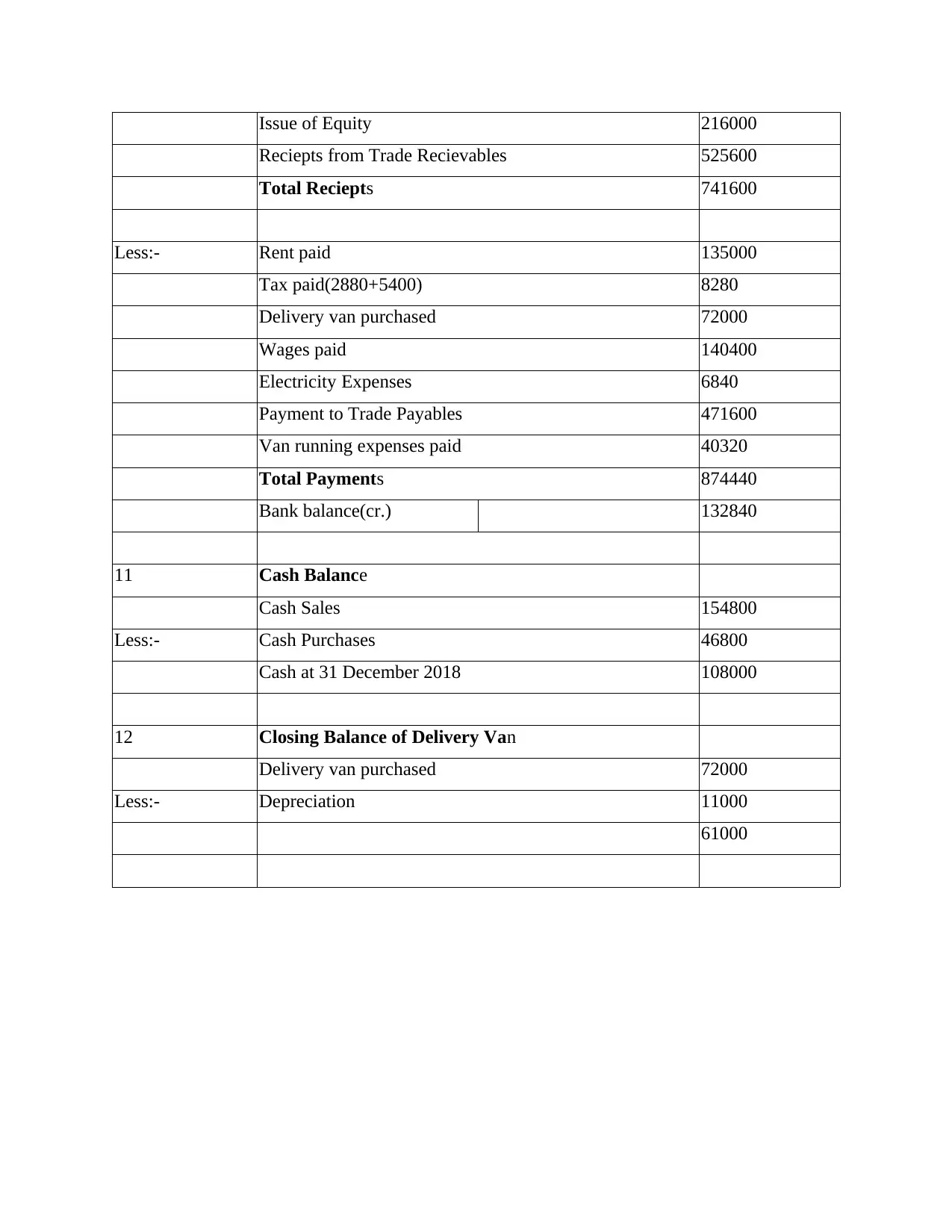
Issue of Equity 216000
Reciepts from Trade Recievables 525600
Total Reciepts 741600
Less:- Rent paid 135000
Tax paid(2880+5400) 8280
Delivery van purchased 72000
Wages paid 140400
Electricity Expenses 6840
Payment to Trade Payables 471600
Van running expenses paid 40320
Total Payments 874440
Bank balance(cr.) 132840
11 Cash Balance
Cash Sales 154800
Less:- Cash Purchases 46800
Cash at 31 December 2018 108000
12 Closing Balance of Delivery Van
Delivery van purchased 72000
Less:- Depreciation 11000
61000
Reciepts from Trade Recievables 525600
Total Reciepts 741600
Less:- Rent paid 135000
Tax paid(2880+5400) 8280
Delivery van purchased 72000
Wages paid 140400
Electricity Expenses 6840
Payment to Trade Payables 471600
Van running expenses paid 40320
Total Payments 874440
Bank balance(cr.) 132840
11 Cash Balance
Cash Sales 154800
Less:- Cash Purchases 46800
Cash at 31 December 2018 108000
12 Closing Balance of Delivery Van
Delivery van purchased 72000
Less:- Depreciation 11000
61000
Paraphrase This Document
Need a fresh take? Get an instant paraphrase of this document with our AI Paraphraser
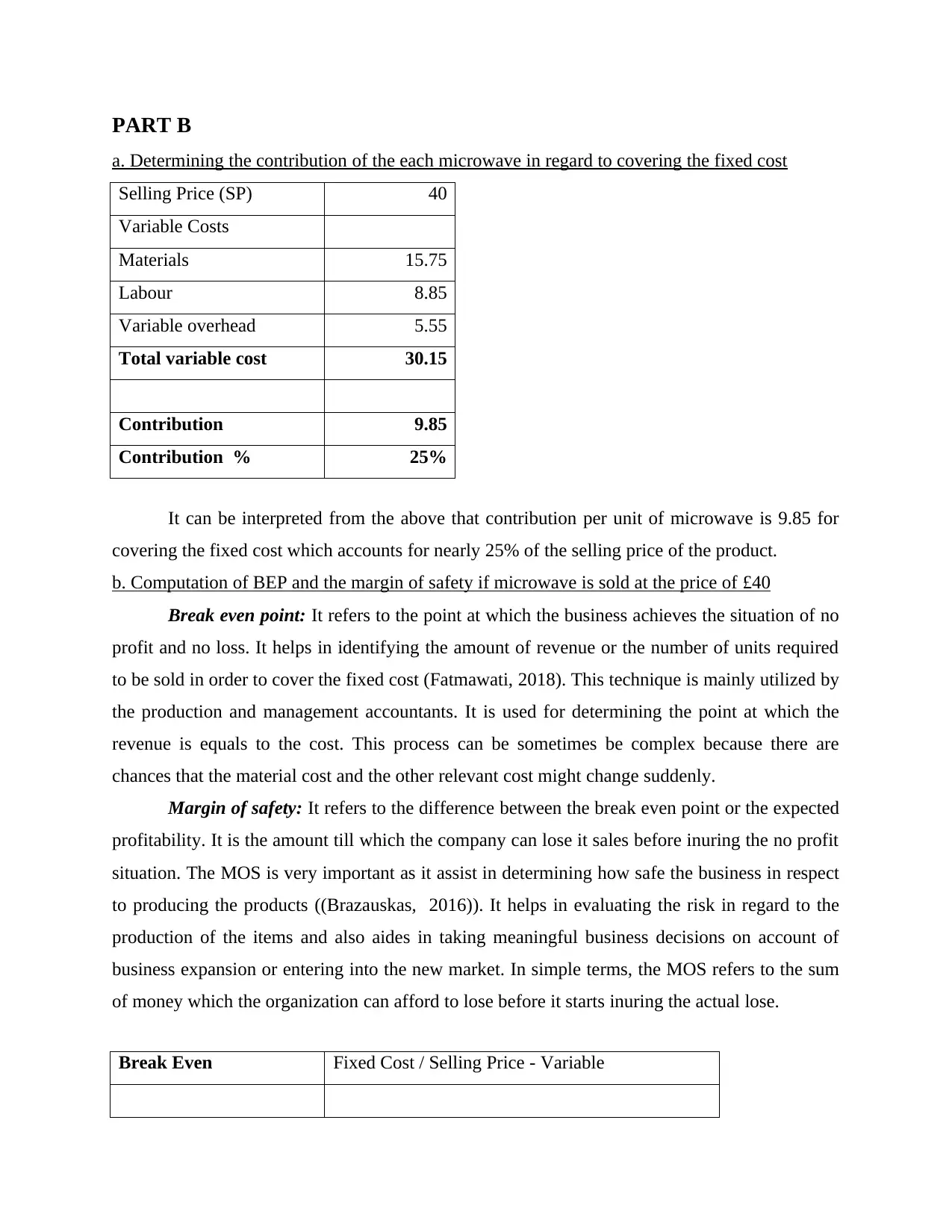
PART B
a. Determining the contribution of the each microwave in regard to covering the fixed cost
Selling Price (SP) 40
Variable Costs
Materials 15.75
Labour 8.85
Variable overhead 5.55
Total variable cost 30.15
Contribution 9.85
Contribution % 25%
It can be interpreted from the above that contribution per unit of microwave is 9.85 for
covering the fixed cost which accounts for nearly 25% of the selling price of the product.
b. Computation of BEP and the margin of safety if microwave is sold at the price of £40
Break even point: It refers to the point at which the business achieves the situation of no
profit and no loss. It helps in identifying the amount of revenue or the number of units required
to be sold in order to cover the fixed cost (Fatmawati, 2018). This technique is mainly utilized by
the production and management accountants. It is used for determining the point at which the
revenue is equals to the cost. This process can be sometimes be complex because there are
chances that the material cost and the other relevant cost might change suddenly.
Margin of safety: It refers to the difference between the break even point or the expected
profitability. It is the amount till which the company can lose it sales before inuring the no profit
situation. The MOS is very important as it assist in determining how safe the business in respect
to producing the products ((Brazauskas, 2016)). It helps in evaluating the risk in regard to the
production of the items and also aides in taking meaningful business decisions on account of
business expansion or entering into the new market. In simple terms, the MOS refers to the sum
of money which the organization can afford to lose before it starts inuring the actual lose.
Break Even Fixed Cost / Selling Price - Variable
a. Determining the contribution of the each microwave in regard to covering the fixed cost
Selling Price (SP) 40
Variable Costs
Materials 15.75
Labour 8.85
Variable overhead 5.55
Total variable cost 30.15
Contribution 9.85
Contribution % 25%
It can be interpreted from the above that contribution per unit of microwave is 9.85 for
covering the fixed cost which accounts for nearly 25% of the selling price of the product.
b. Computation of BEP and the margin of safety if microwave is sold at the price of £40
Break even point: It refers to the point at which the business achieves the situation of no
profit and no loss. It helps in identifying the amount of revenue or the number of units required
to be sold in order to cover the fixed cost (Fatmawati, 2018). This technique is mainly utilized by
the production and management accountants. It is used for determining the point at which the
revenue is equals to the cost. This process can be sometimes be complex because there are
chances that the material cost and the other relevant cost might change suddenly.
Margin of safety: It refers to the difference between the break even point or the expected
profitability. It is the amount till which the company can lose it sales before inuring the no profit
situation. The MOS is very important as it assist in determining how safe the business in respect
to producing the products ((Brazauskas, 2016)). It helps in evaluating the risk in regard to the
production of the items and also aides in taking meaningful business decisions on account of
business expansion or entering into the new market. In simple terms, the MOS refers to the sum
of money which the organization can afford to lose before it starts inuring the actual lose.
Break Even Fixed Cost / Selling Price - Variable
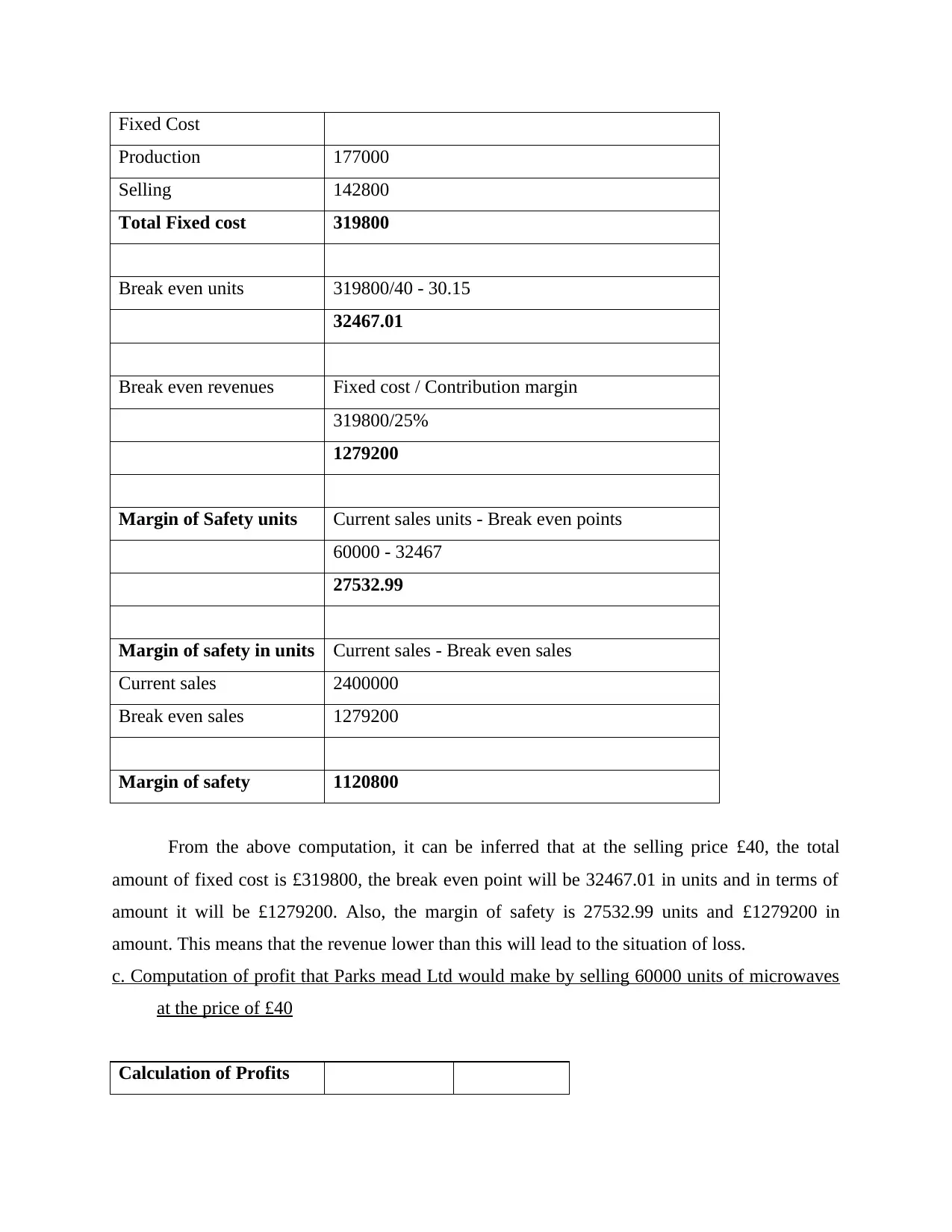
Fixed Cost
Production 177000
Selling 142800
Total Fixed cost 319800
Break even units 319800/40 - 30.15
32467.01
Break even revenues Fixed cost / Contribution margin
319800/25%
1279200
Margin of Safety units Current sales units - Break even points
60000 - 32467
27532.99
Margin of safety in units Current sales - Break even sales
Current sales 2400000
Break even sales 1279200
Margin of safety 1120800
From the above computation, it can be inferred that at the selling price £40, the total
amount of fixed cost is £319800, the break even point will be 32467.01 in units and in terms of
amount it will be £1279200. Also, the margin of safety is 27532.99 units and £1279200 in
amount. This means that the revenue lower than this will lead to the situation of loss.
c. Computation of profit that Parks mead Ltd would make by selling 60000 units of microwaves
at the price of £40
Calculation of Profits
Production 177000
Selling 142800
Total Fixed cost 319800
Break even units 319800/40 - 30.15
32467.01
Break even revenues Fixed cost / Contribution margin
319800/25%
1279200
Margin of Safety units Current sales units - Break even points
60000 - 32467
27532.99
Margin of safety in units Current sales - Break even sales
Current sales 2400000
Break even sales 1279200
Margin of safety 1120800
From the above computation, it can be inferred that at the selling price £40, the total
amount of fixed cost is £319800, the break even point will be 32467.01 in units and in terms of
amount it will be £1279200. Also, the margin of safety is 27532.99 units and £1279200 in
amount. This means that the revenue lower than this will lead to the situation of loss.
c. Computation of profit that Parks mead Ltd would make by selling 60000 units of microwaves
at the price of £40
Calculation of Profits
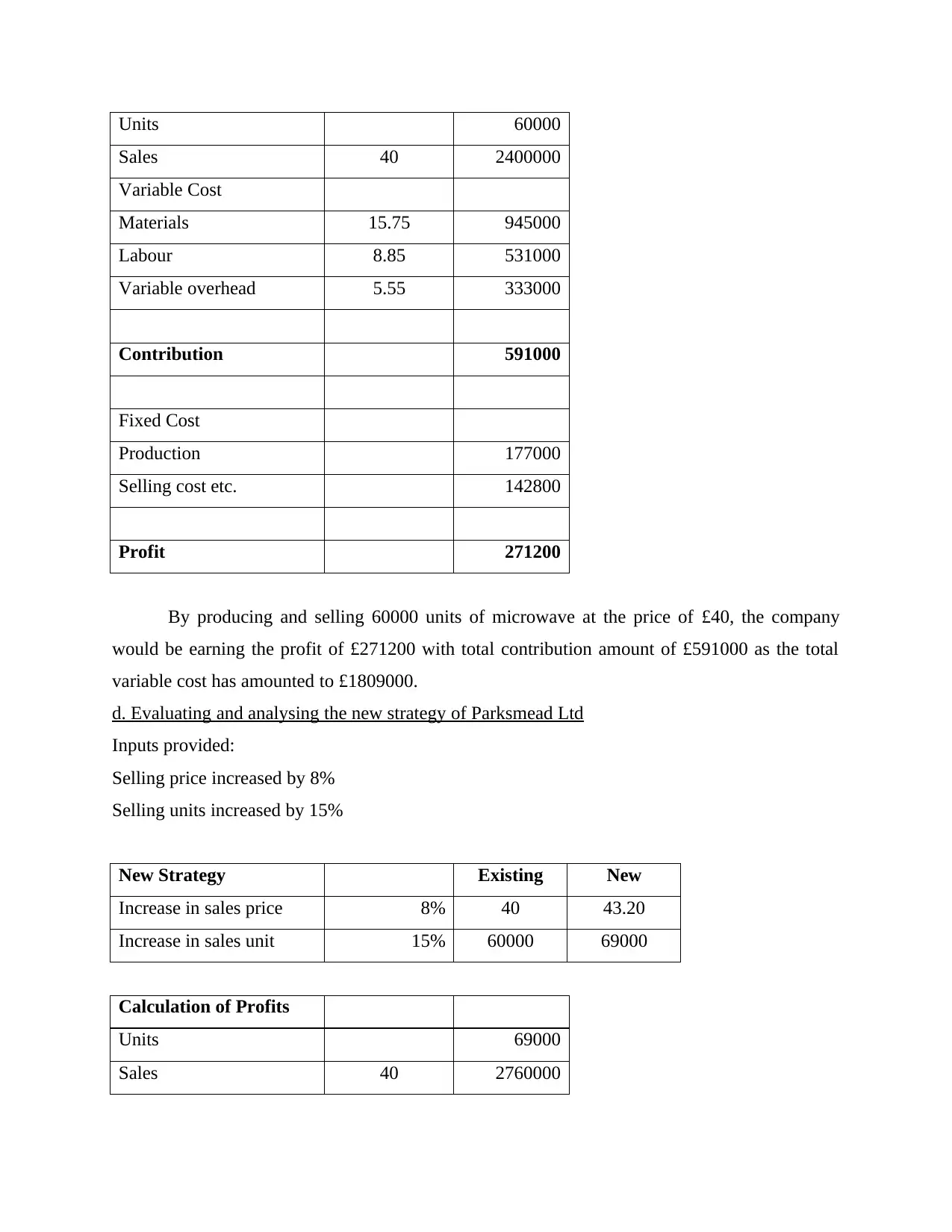
Units 60000
Sales 40 2400000
Variable Cost
Materials 15.75 945000
Labour 8.85 531000
Variable overhead 5.55 333000
Contribution 591000
Fixed Cost
Production 177000
Selling cost etc. 142800
Profit 271200
By producing and selling 60000 units of microwave at the price of £40, the company
would be earning the profit of £271200 with total contribution amount of £591000 as the total
variable cost has amounted to £1809000.
d. Evaluating and analysing the new strategy of Parksmead Ltd
Inputs provided:
Selling price increased by 8%
Selling units increased by 15%
New Strategy Existing New
Increase in sales price 8% 40 43.20
Increase in sales unit 15% 60000 69000
Calculation of Profits
Units 69000
Sales 40 2760000
Sales 40 2400000
Variable Cost
Materials 15.75 945000
Labour 8.85 531000
Variable overhead 5.55 333000
Contribution 591000
Fixed Cost
Production 177000
Selling cost etc. 142800
Profit 271200
By producing and selling 60000 units of microwave at the price of £40, the company
would be earning the profit of £271200 with total contribution amount of £591000 as the total
variable cost has amounted to £1809000.
d. Evaluating and analysing the new strategy of Parksmead Ltd
Inputs provided:
Selling price increased by 8%
Selling units increased by 15%
New Strategy Existing New
Increase in sales price 8% 40 43.20
Increase in sales unit 15% 60000 69000
Calculation of Profits
Units 69000
Sales 40 2760000
Secure Best Marks with AI Grader
Need help grading? Try our AI Grader for instant feedback on your assignments.
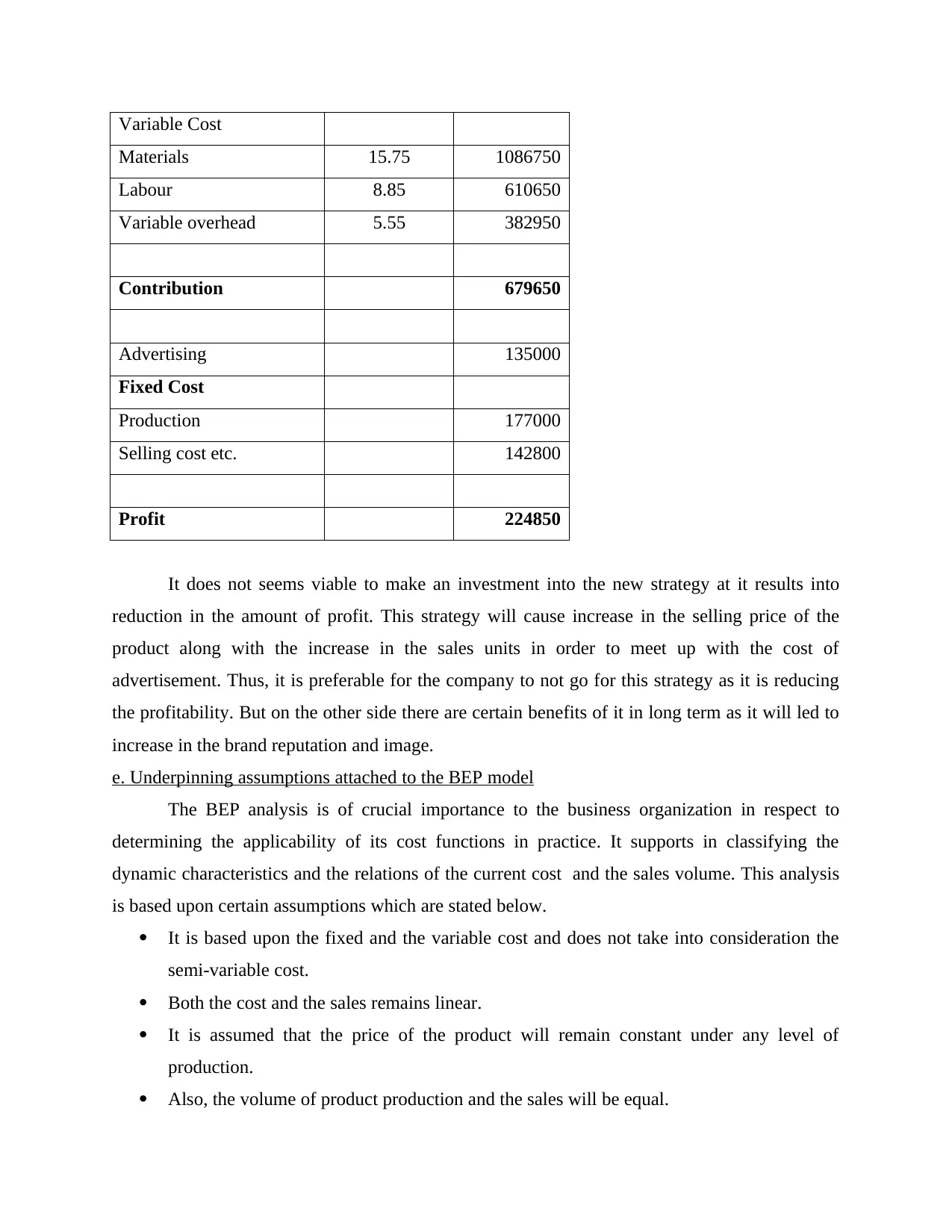
Variable Cost
Materials 15.75 1086750
Labour 8.85 610650
Variable overhead 5.55 382950
Contribution 679650
Advertising 135000
Fixed Cost
Production 177000
Selling cost etc. 142800
Profit 224850
It does not seems viable to make an investment into the new strategy at it results into
reduction in the amount of profit. This strategy will cause increase in the selling price of the
product along with the increase in the sales units in order to meet up with the cost of
advertisement. Thus, it is preferable for the company to not go for this strategy as it is reducing
the profitability. But on the other side there are certain benefits of it in long term as it will led to
increase in the brand reputation and image.
e. Underpinning assumptions attached to the BEP model
The BEP analysis is of crucial importance to the business organization in respect to
determining the applicability of its cost functions in practice. It supports in classifying the
dynamic characteristics and the relations of the current cost and the sales volume. This analysis
is based upon certain assumptions which are stated below.
It is based upon the fixed and the variable cost and does not take into consideration the
semi-variable cost.
Both the cost and the sales remains linear.
It is assumed that the price of the product will remain constant under any level of
production.
Also, the volume of product production and the sales will be equal.
Materials 15.75 1086750
Labour 8.85 610650
Variable overhead 5.55 382950
Contribution 679650
Advertising 135000
Fixed Cost
Production 177000
Selling cost etc. 142800
Profit 224850
It does not seems viable to make an investment into the new strategy at it results into
reduction in the amount of profit. This strategy will cause increase in the selling price of the
product along with the increase in the sales units in order to meet up with the cost of
advertisement. Thus, it is preferable for the company to not go for this strategy as it is reducing
the profitability. But on the other side there are certain benefits of it in long term as it will led to
increase in the brand reputation and image.
e. Underpinning assumptions attached to the BEP model
The BEP analysis is of crucial importance to the business organization in respect to
determining the applicability of its cost functions in practice. It supports in classifying the
dynamic characteristics and the relations of the current cost and the sales volume. This analysis
is based upon certain assumptions which are stated below.
It is based upon the fixed and the variable cost and does not take into consideration the
semi-variable cost.
Both the cost and the sales remains linear.
It is assumed that the price of the product will remain constant under any level of
production.
Also, the volume of product production and the sales will be equal.
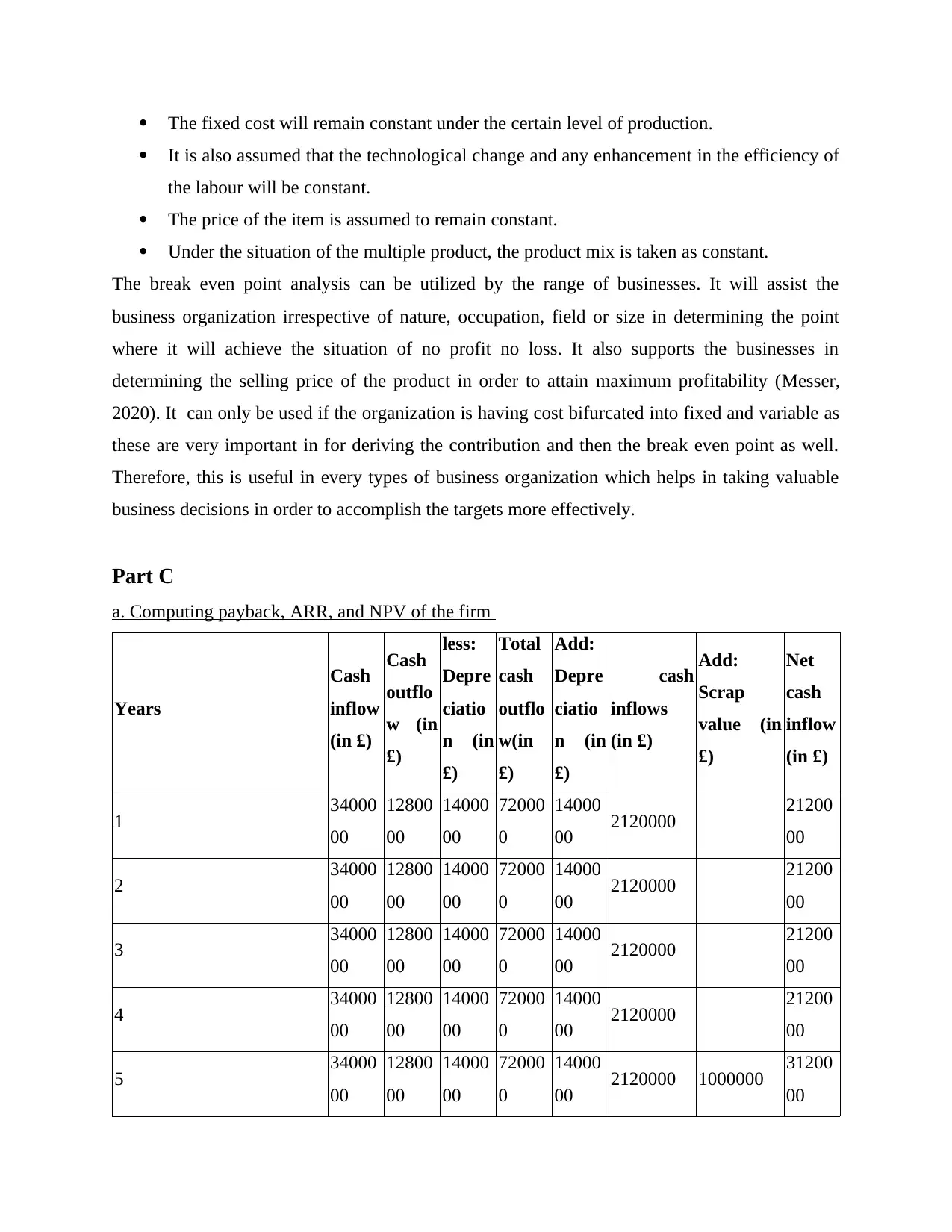
The fixed cost will remain constant under the certain level of production.
It is also assumed that the technological change and any enhancement in the efficiency of
the labour will be constant.
The price of the item is assumed to remain constant.
Under the situation of the multiple product, the product mix is taken as constant.
The break even point analysis can be utilized by the range of businesses. It will assist the
business organization irrespective of nature, occupation, field or size in determining the point
where it will achieve the situation of no profit no loss. It also supports the businesses in
determining the selling price of the product in order to attain maximum profitability (Messer,
2020). It can only be used if the organization is having cost bifurcated into fixed and variable as
these are very important in for deriving the contribution and then the break even point as well.
Therefore, this is useful in every types of business organization which helps in taking valuable
business decisions in order to accomplish the targets more effectively.
Part C
a. Computing payback, ARR, and NPV of the firm
Years
Cash
inflow
(in £)
Cash
outflo
w (in
£)
less:
Depre
ciatio
n (in
£)
Total
cash
outflo
w(in
£)
Add:
Depre
ciatio
n (in
£)
cash
inflows
(in £)
Add:
Scrap
value (in
£)
Net
cash
inflow
(in £)
1 34000
00
12800
00
14000
00
72000
0
14000
00 2120000 21200
00
2 34000
00
12800
00
14000
00
72000
0
14000
00 2120000 21200
00
3 34000
00
12800
00
14000
00
72000
0
14000
00 2120000 21200
00
4 34000
00
12800
00
14000
00
72000
0
14000
00 2120000 21200
00
5 34000
00
12800
00
14000
00
72000
0
14000
00 2120000 1000000 31200
00
It is also assumed that the technological change and any enhancement in the efficiency of
the labour will be constant.
The price of the item is assumed to remain constant.
Under the situation of the multiple product, the product mix is taken as constant.
The break even point analysis can be utilized by the range of businesses. It will assist the
business organization irrespective of nature, occupation, field or size in determining the point
where it will achieve the situation of no profit no loss. It also supports the businesses in
determining the selling price of the product in order to attain maximum profitability (Messer,
2020). It can only be used if the organization is having cost bifurcated into fixed and variable as
these are very important in for deriving the contribution and then the break even point as well.
Therefore, this is useful in every types of business organization which helps in taking valuable
business decisions in order to accomplish the targets more effectively.
Part C
a. Computing payback, ARR, and NPV of the firm
Years
Cash
inflow
(in £)
Cash
outflo
w (in
£)
less:
Depre
ciatio
n (in
£)
Total
cash
outflo
w(in
£)
Add:
Depre
ciatio
n (in
£)
cash
inflows
(in £)
Add:
Scrap
value (in
£)
Net
cash
inflow
(in £)
1 34000
00
12800
00
14000
00
72000
0
14000
00 2120000 21200
00
2 34000
00
12800
00
14000
00
72000
0
14000
00 2120000 21200
00
3 34000
00
12800
00
14000
00
72000
0
14000
00 2120000 21200
00
4 34000
00
12800
00
14000
00
72000
0
14000
00 2120000 21200
00
5 34000
00
12800
00
14000
00
72000
0
14000
00 2120000 1000000 31200
00

Net present value
Years Net cash
inflow (in £) Discounted value Net discounted Cash inflows
1 2120000 0.9174311927 1944954.13
2 2120000 0.8416799933 1784361.59
3 2120000 0.7721834801 1637028.98
4 2120000 0.7084252111 1501861.45
5 3120000 0.6499313863 2027785.93
Total
discounted
cash inflow
8895992.06
less: initial
outlay 8000000
NPV 895992.06
Interpretation- The above analysis represents that the value of NPV Accounted as
895992.06 which reflects a positive value that in turn means that the project would be profitable
for Clifford ans it should go for making an investment into the proposal (Mechler, 2016). It is
been computed by subtracting initial investment from the discounted cash inflows.
Payback period
Years Net cash inflow (in £) Cumulative cash inflows
(in £)
1 2120000 2120000
2 2120000 4240000
3 2120000 6360000
4 2120000 8480000
5 3120000 11600000
Payback period 3
Years Net cash
inflow (in £) Discounted value Net discounted Cash inflows
1 2120000 0.9174311927 1944954.13
2 2120000 0.8416799933 1784361.59
3 2120000 0.7721834801 1637028.98
4 2120000 0.7084252111 1501861.45
5 3120000 0.6499313863 2027785.93
Total
discounted
cash inflow
8895992.06
less: initial
outlay 8000000
NPV 895992.06
Interpretation- The above analysis represents that the value of NPV Accounted as
895992.06 which reflects a positive value that in turn means that the project would be profitable
for Clifford ans it should go for making an investment into the proposal (Mechler, 2016). It is
been computed by subtracting initial investment from the discounted cash inflows.
Payback period
Years Net cash inflow (in £) Cumulative cash inflows
(in £)
1 2120000 2120000
2 2120000 4240000
3 2120000 6360000
4 2120000 8480000
5 3120000 11600000
Payback period 3
Paraphrase This Document
Need a fresh take? Get an instant paraphrase of this document with our AI Paraphraser
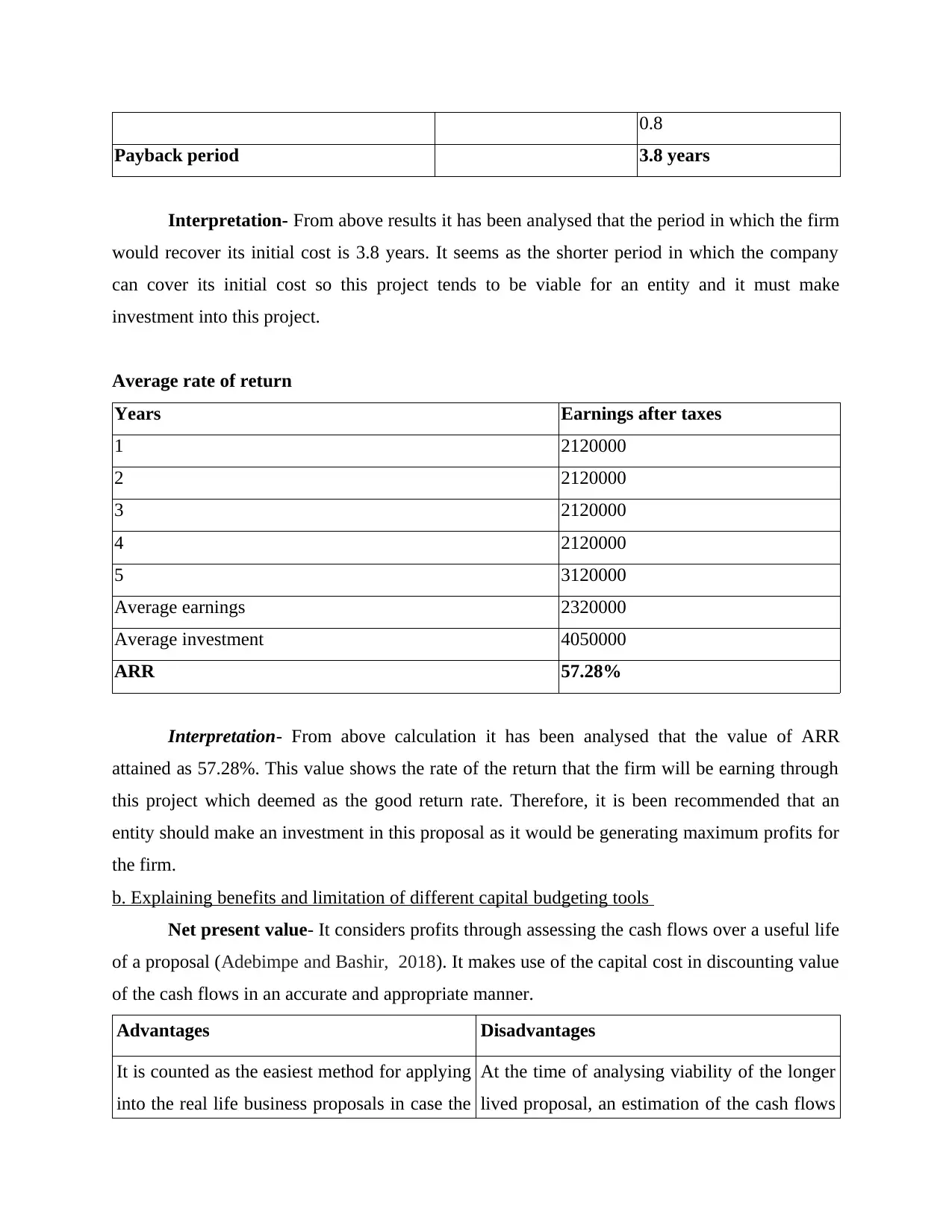
0.8
Payback period 3.8 years
Interpretation- From above results it has been analysed that the period in which the firm
would recover its initial cost is 3.8 years. It seems as the shorter period in which the company
can cover its initial cost so this project tends to be viable for an entity and it must make
investment into this project.
Average rate of return
Years Earnings after taxes
1 2120000
2 2120000
3 2120000
4 2120000
5 3120000
Average earnings 2320000
Average investment 4050000
ARR 57.28%
Interpretation- From above calculation it has been analysed that the value of ARR
attained as 57.28%. This value shows the rate of the return that the firm will be earning through
this project which deemed as the good return rate. Therefore, it is been recommended that an
entity should make an investment in this proposal as it would be generating maximum profits for
the firm.
b. Explaining benefits and limitation of different capital budgeting tools
Net present value- It considers profits through assessing the cash flows over a useful life
of a proposal (Adebimpe and Bashir, 2018). It makes use of the capital cost in discounting value
of the cash flows in an accurate and appropriate manner.
Advantages Disadvantages
It is counted as the easiest method for applying
into the real life business proposals in case the
At the time of analysing viability of the longer
lived proposal, an estimation of the cash flows
Payback period 3.8 years
Interpretation- From above results it has been analysed that the period in which the firm
would recover its initial cost is 3.8 years. It seems as the shorter period in which the company
can cover its initial cost so this project tends to be viable for an entity and it must make
investment into this project.
Average rate of return
Years Earnings after taxes
1 2120000
2 2120000
3 2120000
4 2120000
5 3120000
Average earnings 2320000
Average investment 4050000
ARR 57.28%
Interpretation- From above calculation it has been analysed that the value of ARR
attained as 57.28%. This value shows the rate of the return that the firm will be earning through
this project which deemed as the good return rate. Therefore, it is been recommended that an
entity should make an investment in this proposal as it would be generating maximum profits for
the firm.
b. Explaining benefits and limitation of different capital budgeting tools
Net present value- It considers profits through assessing the cash flows over a useful life
of a proposal (Adebimpe and Bashir, 2018). It makes use of the capital cost in discounting value
of the cash flows in an accurate and appropriate manner.
Advantages Disadvantages
It is counted as the easiest method for applying
into the real life business proposals in case the
At the time of analysing viability of the longer
lived proposal, an estimation of the cash flows
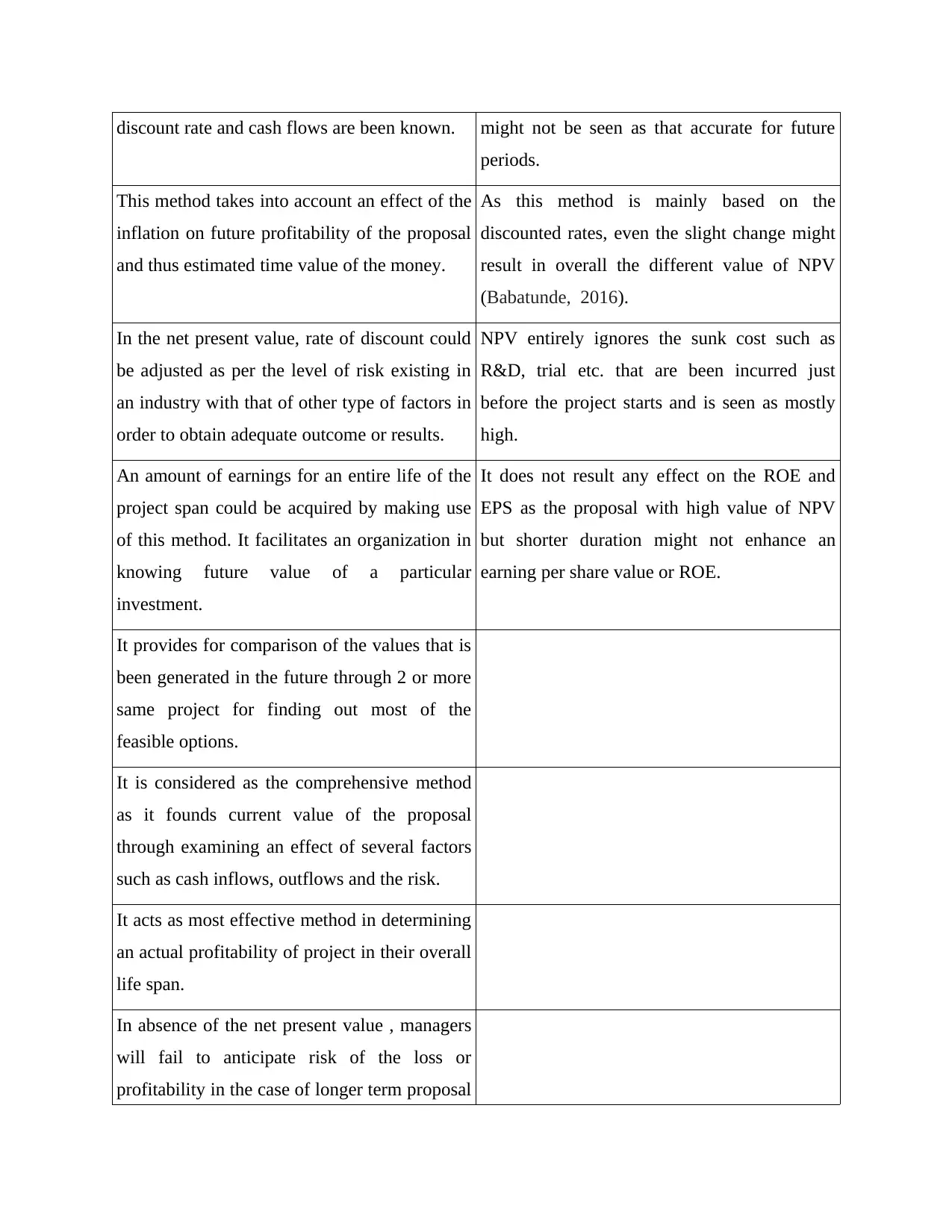
discount rate and cash flows are been known. might not be seen as that accurate for future
periods.
This method takes into account an effect of the
inflation on future profitability of the proposal
and thus estimated time value of the money.
As this method is mainly based on the
discounted rates, even the slight change might
result in overall the different value of NPV
(Babatunde, 2016).
In the net present value, rate of discount could
be adjusted as per the level of risk existing in
an industry with that of other type of factors in
order to obtain adequate outcome or results.
NPV entirely ignores the sunk cost such as
R&D, trial etc. that are been incurred just
before the project starts and is seen as mostly
high.
An amount of earnings for an entire life of the
project span could be acquired by making use
of this method. It facilitates an organization in
knowing future value of a particular
investment.
It does not result any effect on the ROE and
EPS as the proposal with high value of NPV
but shorter duration might not enhance an
earning per share value or ROE.
It provides for comparison of the values that is
been generated in the future through 2 or more
same project for finding out most of the
feasible options.
It is considered as the comprehensive method
as it founds current value of the proposal
through examining an effect of several factors
such as cash inflows, outflows and the risk.
It acts as most effective method in determining
an actual profitability of project in their overall
life span.
In absence of the net present value , managers
will fail to anticipate risk of the loss or
profitability in the case of longer term proposal
periods.
This method takes into account an effect of the
inflation on future profitability of the proposal
and thus estimated time value of the money.
As this method is mainly based on the
discounted rates, even the slight change might
result in overall the different value of NPV
(Babatunde, 2016).
In the net present value, rate of discount could
be adjusted as per the level of risk existing in
an industry with that of other type of factors in
order to obtain adequate outcome or results.
NPV entirely ignores the sunk cost such as
R&D, trial etc. that are been incurred just
before the project starts and is seen as mostly
high.
An amount of earnings for an entire life of the
project span could be acquired by making use
of this method. It facilitates an organization in
knowing future value of a particular
investment.
It does not result any effect on the ROE and
EPS as the proposal with high value of NPV
but shorter duration might not enhance an
earning per share value or ROE.
It provides for comparison of the values that is
been generated in the future through 2 or more
same project for finding out most of the
feasible options.
It is considered as the comprehensive method
as it founds current value of the proposal
through examining an effect of several factors
such as cash inflows, outflows and the risk.
It acts as most effective method in determining
an actual profitability of project in their overall
life span.
In absence of the net present value , managers
will fail to anticipate risk of the loss or
profitability in the case of longer term proposal
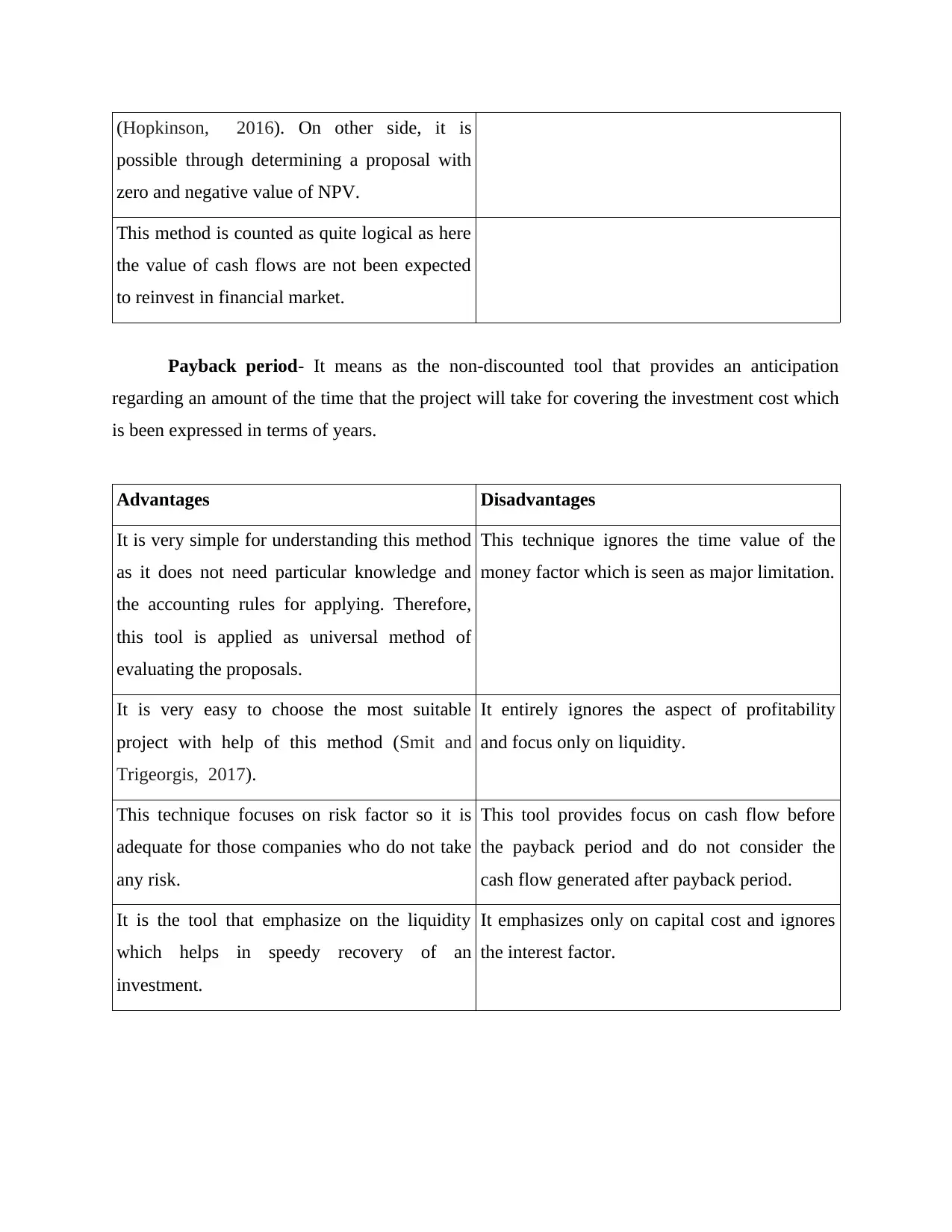
(Hopkinson, 2016). On other side, it is
possible through determining a proposal with
zero and negative value of NPV.
This method is counted as quite logical as here
the value of cash flows are not been expected
to reinvest in financial market.
Payback period- It means as the non-discounted tool that provides an anticipation
regarding an amount of the time that the project will take for covering the investment cost which
is been expressed in terms of years.
Advantages Disadvantages
It is very simple for understanding this method
as it does not need particular knowledge and
the accounting rules for applying. Therefore,
this tool is applied as universal method of
evaluating the proposals.
This technique ignores the time value of the
money factor which is seen as major limitation.
It is very easy to choose the most suitable
project with help of this method (Smit and
Trigeorgis, 2017).
It entirely ignores the aspect of profitability
and focus only on liquidity.
This technique focuses on risk factor so it is
adequate for those companies who do not take
any risk.
This tool provides focus on cash flow before
the payback period and do not consider the
cash flow generated after payback period.
It is the tool that emphasize on the liquidity
which helps in speedy recovery of an
investment.
It emphasizes only on capital cost and ignores
the interest factor.
possible through determining a proposal with
zero and negative value of NPV.
This method is counted as quite logical as here
the value of cash flows are not been expected
to reinvest in financial market.
Payback period- It means as the non-discounted tool that provides an anticipation
regarding an amount of the time that the project will take for covering the investment cost which
is been expressed in terms of years.
Advantages Disadvantages
It is very simple for understanding this method
as it does not need particular knowledge and
the accounting rules for applying. Therefore,
this tool is applied as universal method of
evaluating the proposals.
This technique ignores the time value of the
money factor which is seen as major limitation.
It is very easy to choose the most suitable
project with help of this method (Smit and
Trigeorgis, 2017).
It entirely ignores the aspect of profitability
and focus only on liquidity.
This technique focuses on risk factor so it is
adequate for those companies who do not take
any risk.
This tool provides focus on cash flow before
the payback period and do not consider the
cash flow generated after payback period.
It is the tool that emphasize on the liquidity
which helps in speedy recovery of an
investment.
It emphasizes only on capital cost and ignores
the interest factor.
Secure Best Marks with AI Grader
Need help grading? Try our AI Grader for instant feedback on your assignments.
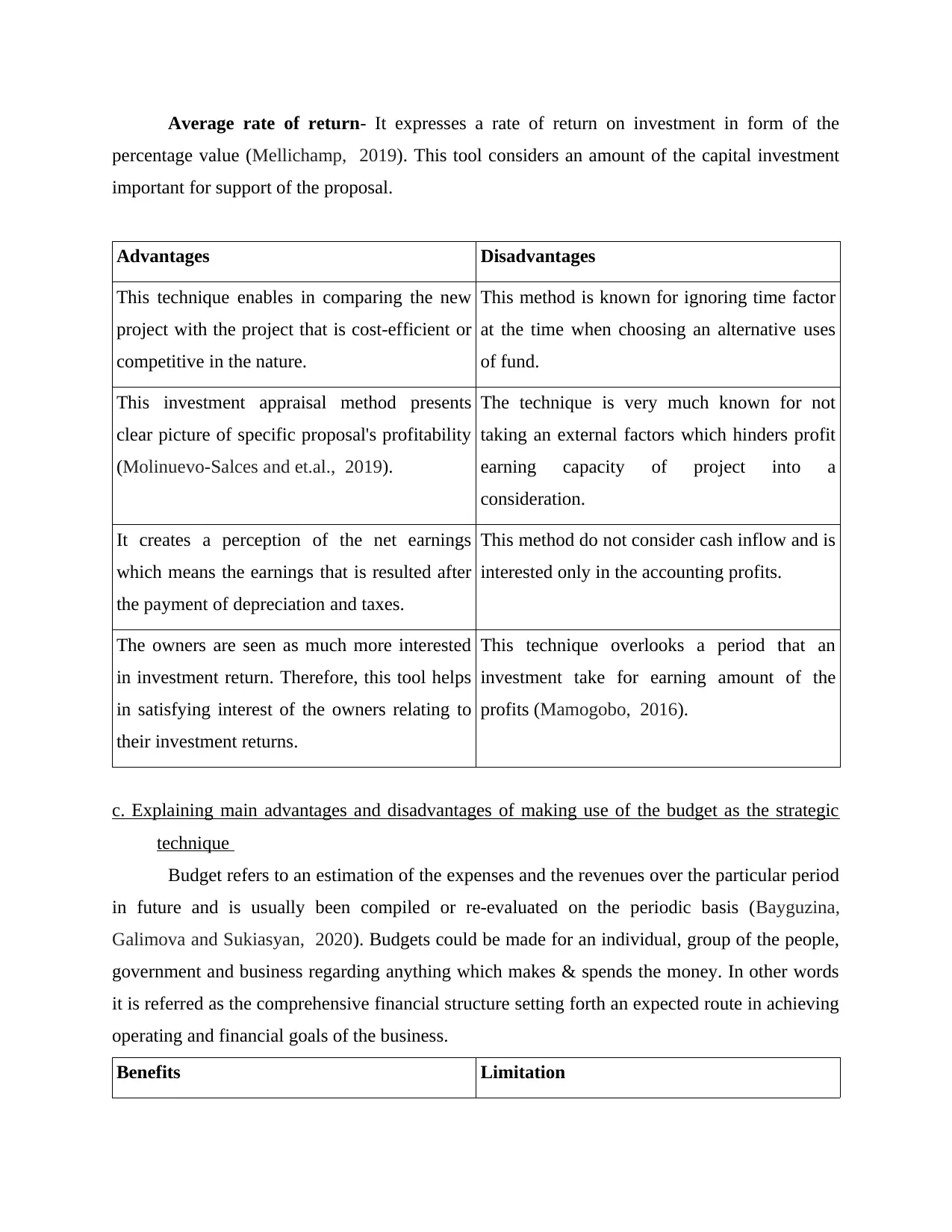
Average rate of return- It expresses a rate of return on investment in form of the
percentage value (Mellichamp, 2019). This tool considers an amount of the capital investment
important for support of the proposal.
Advantages Disadvantages
This technique enables in comparing the new
project with the project that is cost-efficient or
competitive in the nature.
This method is known for ignoring time factor
at the time when choosing an alternative uses
of fund.
This investment appraisal method presents
clear picture of specific proposal's profitability
(Molinuevo-Salces and et.al., 2019).
The technique is very much known for not
taking an external factors which hinders profit
earning capacity of project into a
consideration.
It creates a perception of the net earnings
which means the earnings that is resulted after
the payment of depreciation and taxes.
This method do not consider cash inflow and is
interested only in the accounting profits.
The owners are seen as much more interested
in investment return. Therefore, this tool helps
in satisfying interest of the owners relating to
their investment returns.
This technique overlooks a period that an
investment take for earning amount of the
profits (Mamogobo, 2016).
c. Explaining main advantages and disadvantages of making use of the budget as the strategic
technique
Budget refers to an estimation of the expenses and the revenues over the particular period
in future and is usually been compiled or re-evaluated on the periodic basis (Bayguzina,
Galimova and Sukiasyan, 2020). Budgets could be made for an individual, group of the people,
government and business regarding anything which makes & spends the money. In other words
it is referred as the comprehensive financial structure setting forth an expected route in achieving
operating and financial goals of the business.
Benefits Limitation
percentage value (Mellichamp, 2019). This tool considers an amount of the capital investment
important for support of the proposal.
Advantages Disadvantages
This technique enables in comparing the new
project with the project that is cost-efficient or
competitive in the nature.
This method is known for ignoring time factor
at the time when choosing an alternative uses
of fund.
This investment appraisal method presents
clear picture of specific proposal's profitability
(Molinuevo-Salces and et.al., 2019).
The technique is very much known for not
taking an external factors which hinders profit
earning capacity of project into a
consideration.
It creates a perception of the net earnings
which means the earnings that is resulted after
the payment of depreciation and taxes.
This method do not consider cash inflow and is
interested only in the accounting profits.
The owners are seen as much more interested
in investment return. Therefore, this tool helps
in satisfying interest of the owners relating to
their investment returns.
This technique overlooks a period that an
investment take for earning amount of the
profits (Mamogobo, 2016).
c. Explaining main advantages and disadvantages of making use of the budget as the strategic
technique
Budget refers to an estimation of the expenses and the revenues over the particular period
in future and is usually been compiled or re-evaluated on the periodic basis (Bayguzina,
Galimova and Sukiasyan, 2020). Budgets could be made for an individual, group of the people,
government and business regarding anything which makes & spends the money. In other words
it is referred as the comprehensive financial structure setting forth an expected route in achieving
operating and financial goals of the business.
Benefits Limitation
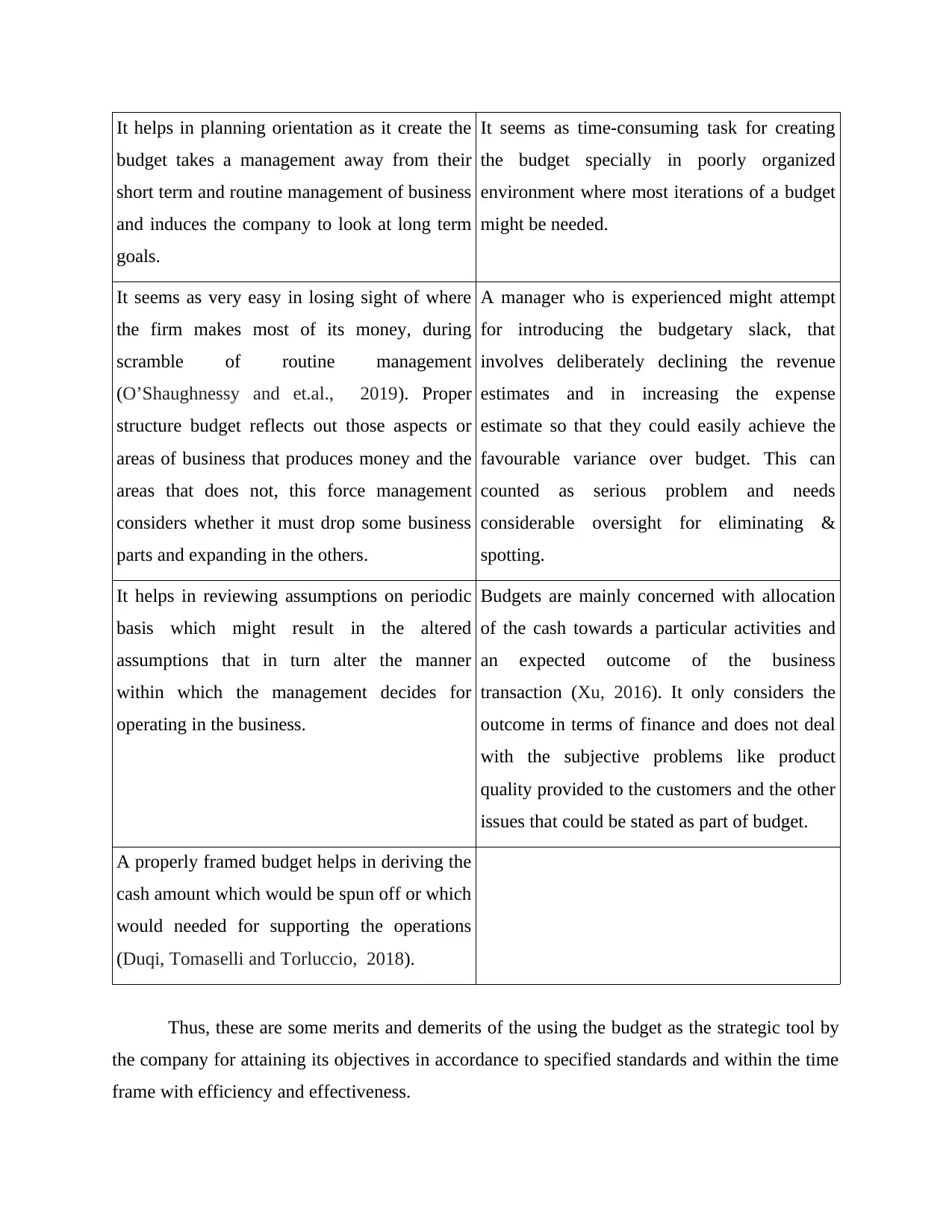
It helps in planning orientation as it create the
budget takes a management away from their
short term and routine management of business
and induces the company to look at long term
goals.
It seems as time-consuming task for creating
the budget specially in poorly organized
environment where most iterations of a budget
might be needed.
It seems as very easy in losing sight of where
the firm makes most of its money, during
scramble of routine management
(O’Shaughnessy and et.al., 2019). Proper
structure budget reflects out those aspects or
areas of business that produces money and the
areas that does not, this force management
considers whether it must drop some business
parts and expanding in the others.
A manager who is experienced might attempt
for introducing the budgetary slack, that
involves deliberately declining the revenue
estimates and in increasing the expense
estimate so that they could easily achieve the
favourable variance over budget. This can
counted as serious problem and needs
considerable oversight for eliminating &
spotting.
It helps in reviewing assumptions on periodic
basis which might result in the altered
assumptions that in turn alter the manner
within which the management decides for
operating in the business.
Budgets are mainly concerned with allocation
of the cash towards a particular activities and
an expected outcome of the business
transaction (Xu, 2016). It only considers the
outcome in terms of finance and does not deal
with the subjective problems like product
quality provided to the customers and the other
issues that could be stated as part of budget.
A properly framed budget helps in deriving the
cash amount which would be spun off or which
would needed for supporting the operations
(Duqi, Tomaselli and Torluccio, 2018).
Thus, these are some merits and demerits of the using the budget as the strategic tool by
the company for attaining its objectives in accordance to specified standards and within the time
frame with efficiency and effectiveness.
budget takes a management away from their
short term and routine management of business
and induces the company to look at long term
goals.
It seems as time-consuming task for creating
the budget specially in poorly organized
environment where most iterations of a budget
might be needed.
It seems as very easy in losing sight of where
the firm makes most of its money, during
scramble of routine management
(O’Shaughnessy and et.al., 2019). Proper
structure budget reflects out those aspects or
areas of business that produces money and the
areas that does not, this force management
considers whether it must drop some business
parts and expanding in the others.
A manager who is experienced might attempt
for introducing the budgetary slack, that
involves deliberately declining the revenue
estimates and in increasing the expense
estimate so that they could easily achieve the
favourable variance over budget. This can
counted as serious problem and needs
considerable oversight for eliminating &
spotting.
It helps in reviewing assumptions on periodic
basis which might result in the altered
assumptions that in turn alter the manner
within which the management decides for
operating in the business.
Budgets are mainly concerned with allocation
of the cash towards a particular activities and
an expected outcome of the business
transaction (Xu, 2016). It only considers the
outcome in terms of finance and does not deal
with the subjective problems like product
quality provided to the customers and the other
issues that could be stated as part of budget.
A properly framed budget helps in deriving the
cash amount which would be spun off or which
would needed for supporting the operations
(Duqi, Tomaselli and Torluccio, 2018).
Thus, these are some merits and demerits of the using the budget as the strategic tool by
the company for attaining its objectives in accordance to specified standards and within the time
frame with efficiency and effectiveness.
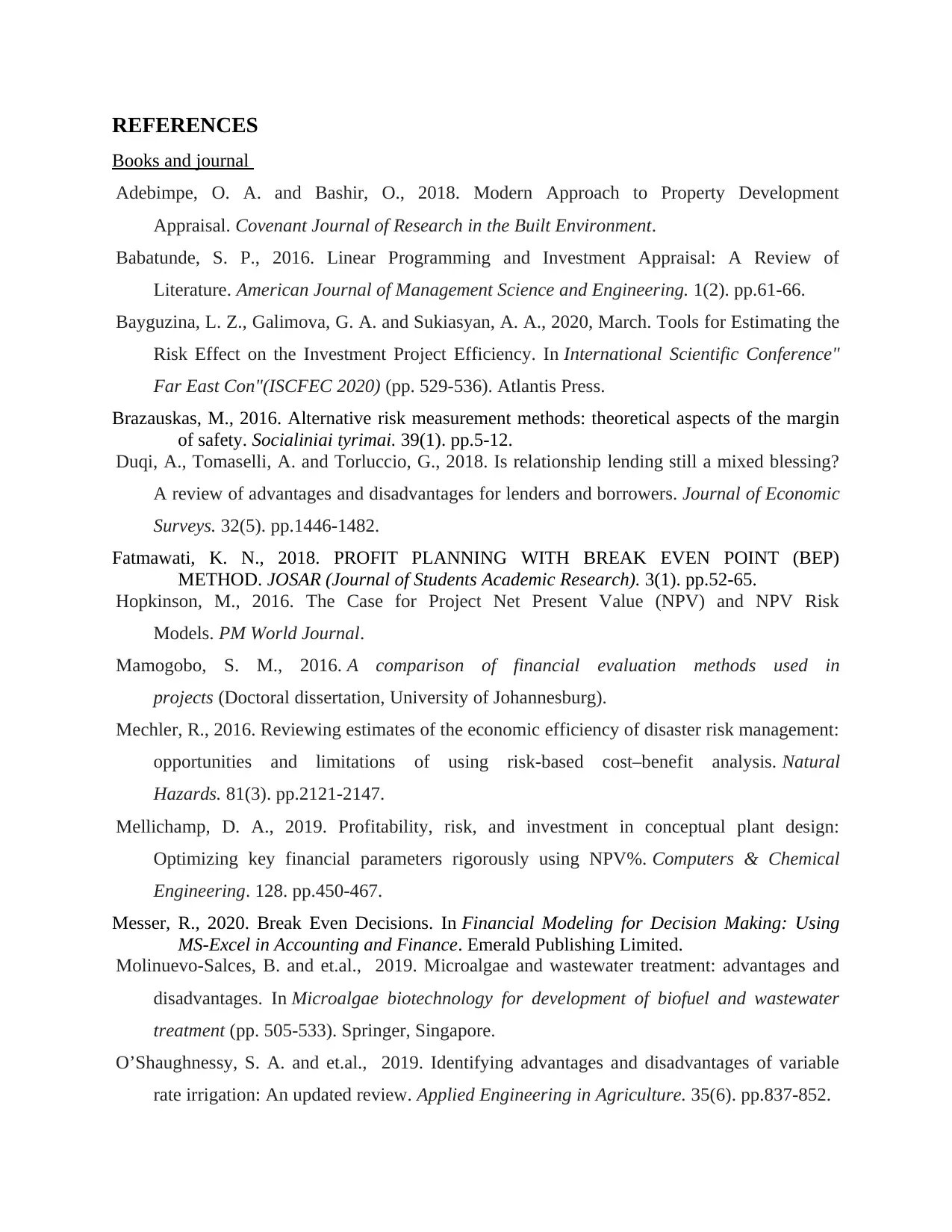
REFERENCES
Books and journal
Adebimpe, O. A. and Bashir, O., 2018. Modern Approach to Property Development
Appraisal. Covenant Journal of Research in the Built Environment.
Babatunde, S. P., 2016. Linear Programming and Investment Appraisal: A Review of
Literature. American Journal of Management Science and Engineering. 1(2). pp.61-66.
Bayguzina, L. Z., Galimova, G. A. and Sukiasyan, A. A., 2020, March. Tools for Estimating the
Risk Effect on the Investment Project Efficiency. In International Scientific Conference"
Far East Con"(ISCFEC 2020) (pp. 529-536). Atlantis Press.
Brazauskas, M., 2016. Alternative risk measurement methods: theoretical aspects of the margin
of safety. Socialiniai tyrimai. 39(1). pp.5-12.
Duqi, A., Tomaselli, A. and Torluccio, G., 2018. Is relationship lending still a mixed blessing?
A review of advantages and disadvantages for lenders and borrowers. Journal of Economic
Surveys. 32(5). pp.1446-1482.
Fatmawati, K. N., 2018. PROFIT PLANNING WITH BREAK EVEN POINT (BEP)
METHOD. JOSAR (Journal of Students Academic Research). 3(1). pp.52-65.
Hopkinson, M., 2016. The Case for Project Net Present Value (NPV) and NPV Risk
Models. PM World Journal.
Mamogobo, S. M., 2016. A comparison of financial evaluation methods used in
projects (Doctoral dissertation, University of Johannesburg).
Mechler, R., 2016. Reviewing estimates of the economic efficiency of disaster risk management:
opportunities and limitations of using risk-based cost–benefit analysis. Natural
Hazards. 81(3). pp.2121-2147.
Mellichamp, D. A., 2019. Profitability, risk, and investment in conceptual plant design:
Optimizing key financial parameters rigorously using NPV%. Computers & Chemical
Engineering. 128. pp.450-467.
Messer, R., 2020. Break Even Decisions. In Financial Modeling for Decision Making: Using
MS-Excel in Accounting and Finance. Emerald Publishing Limited.
Molinuevo-Salces, B. and et.al., 2019. Microalgae and wastewater treatment: advantages and
disadvantages. In Microalgae biotechnology for development of biofuel and wastewater
treatment (pp. 505-533). Springer, Singapore.
O’Shaughnessy, S. A. and et.al., 2019. Identifying advantages and disadvantages of variable
rate irrigation: An updated review. Applied Engineering in Agriculture. 35(6). pp.837-852.
Books and journal
Adebimpe, O. A. and Bashir, O., 2018. Modern Approach to Property Development
Appraisal. Covenant Journal of Research in the Built Environment.
Babatunde, S. P., 2016. Linear Programming and Investment Appraisal: A Review of
Literature. American Journal of Management Science and Engineering. 1(2). pp.61-66.
Bayguzina, L. Z., Galimova, G. A. and Sukiasyan, A. A., 2020, March. Tools for Estimating the
Risk Effect on the Investment Project Efficiency. In International Scientific Conference"
Far East Con"(ISCFEC 2020) (pp. 529-536). Atlantis Press.
Brazauskas, M., 2016. Alternative risk measurement methods: theoretical aspects of the margin
of safety. Socialiniai tyrimai. 39(1). pp.5-12.
Duqi, A., Tomaselli, A. and Torluccio, G., 2018. Is relationship lending still a mixed blessing?
A review of advantages and disadvantages for lenders and borrowers. Journal of Economic
Surveys. 32(5). pp.1446-1482.
Fatmawati, K. N., 2018. PROFIT PLANNING WITH BREAK EVEN POINT (BEP)
METHOD. JOSAR (Journal of Students Academic Research). 3(1). pp.52-65.
Hopkinson, M., 2016. The Case for Project Net Present Value (NPV) and NPV Risk
Models. PM World Journal.
Mamogobo, S. M., 2016. A comparison of financial evaluation methods used in
projects (Doctoral dissertation, University of Johannesburg).
Mechler, R., 2016. Reviewing estimates of the economic efficiency of disaster risk management:
opportunities and limitations of using risk-based cost–benefit analysis. Natural
Hazards. 81(3). pp.2121-2147.
Mellichamp, D. A., 2019. Profitability, risk, and investment in conceptual plant design:
Optimizing key financial parameters rigorously using NPV%. Computers & Chemical
Engineering. 128. pp.450-467.
Messer, R., 2020. Break Even Decisions. In Financial Modeling for Decision Making: Using
MS-Excel in Accounting and Finance. Emerald Publishing Limited.
Molinuevo-Salces, B. and et.al., 2019. Microalgae and wastewater treatment: advantages and
disadvantages. In Microalgae biotechnology for development of biofuel and wastewater
treatment (pp. 505-533). Springer, Singapore.
O’Shaughnessy, S. A. and et.al., 2019. Identifying advantages and disadvantages of variable
rate irrigation: An updated review. Applied Engineering in Agriculture. 35(6). pp.837-852.
Paraphrase This Document
Need a fresh take? Get an instant paraphrase of this document with our AI Paraphraser

Smit, H. T. and Trigeorgis, L., 2017. Strategic NPV: Real options and strategic games under
different information structures. Strategic Management Journal. 38(13). pp.2555-2578.
Xu, Z., 2016. Premium Payback Period Model and its Application in Stock Investment (Doctoral
dissertation, Durham University).
different information structures. Strategic Management Journal. 38(13). pp.2555-2578.
Xu, Z., 2016. Premium Payback Period Model and its Application in Stock Investment (Doctoral
dissertation, Durham University).
1 out of 20
Related Documents
Your All-in-One AI-Powered Toolkit for Academic Success.
+13062052269
info@desklib.com
Available 24*7 on WhatsApp / Email
![[object Object]](/_next/static/media/star-bottom.7253800d.svg)
Unlock your academic potential
© 2024 | Zucol Services PVT LTD | All rights reserved.





